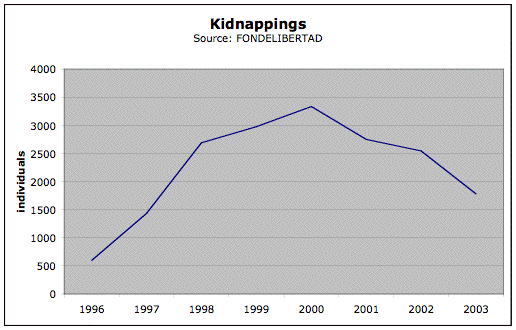
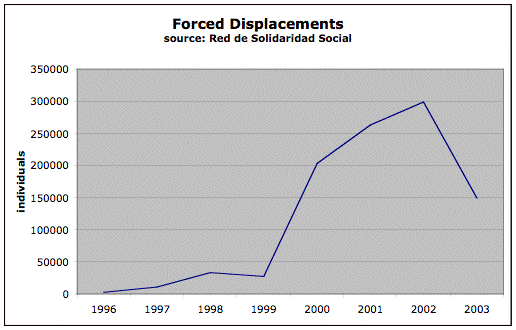
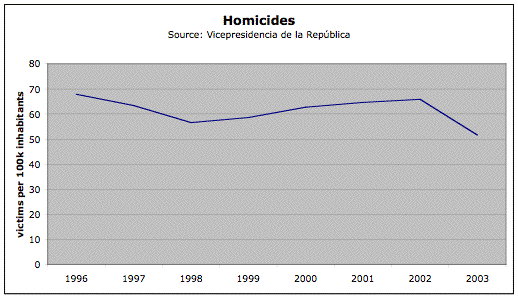
Since becoming a republic in 1819, Colombia has experienced periodic surges of violence (Economist). The current cycle of violence is aggravated by drug revenues that flow to extralegal armed groups, and the United States has become involved in the conflict. Originally the American role was limited to providing assistance for the counternarcotics efforts of the Colombian state, but since 9/11 those restrictions have been relaxed, and under the justification of fighting terrorism, the U.S. is even funding army operations to protect an Occidental Petroleum pipeline in the northeast of the country (Miller). American contractors fumigate coca crops, military advisors train military and police units, and the intelligence community cooperates with Colombia to fight the Marxist guerrilla insurgents. This paper will discuss the effects of this involvement, and advocate for American disengagement. Has U.S. involvement had any discernible effect on the civil war? What factors account for the violence there?
A brief historical review will help explain the current situation, which is a two- or three-sided civil war that has lasted for forty years and occasioned gross human rights violations by all parties. The country is known as one of the more industrialized of Latin America, and enjoys significant resource wealth, particularly coal, emeralds, petroleum, and biodiversity. Yet, 55% of the population was under the poverty line in 2001 (CIA).
After independence from Spain, the national elite never reached consensus on key problems regarding the future of the country, including organization on a federal or unitary system, industry versus agriculture in the economy, and the role of the Catholic Church in society. The 19th century saw repeated wars between the Liberal and Conservative parties over these issues. In the 20th century, the country industrialized thanks to revenues from coffee exports, and industrialization brought with it an organized working class. This challenged the power of the oligarchy, some of whose members traced their lineage directly back to the colonial elite, if not to the original Spanish conquest of the region (MacEoin 13). Elites all over Latin America have been characterized by their absolute intransigence: military governments have bitterly repressed challenges to their rule in Argentina and elsewhere; the old Mexican elite only lost its grip after an absolute explosion of popular resistance during the Revolution.
Civilian administration replaced a brief, anomalous period of military rule in 1958, for which reason Colombia is often called "the oldest democracy in Latin America", but this is misleading. From 1958 to 1972 the government operated under a "National Front" arrangement under which the presidency alternated between the Liberals and Conservatives every four years, and the congress and public offices were split equally between them. This led to short-term regime stability, as the two major parties which had contended against each other for so long finally had a rapprochement, but they excluded other political forces, so the actual quality of that democracy is highly questionable.
It was during the National Front period that the guerrilla movements were founded. The ELN [Army of National Liberation] and FARC [Revolutionary Armed Forces of Colombia] have survived since 1964, financing themselves by kidnapping wealthy and middle-class individuals for ransom, and taxing economic activity in their territories, including coca cultivation and cocaine production. It is also alleged that they participate in drug trafficking itself, which they deny.
The paramilitary groups, known as "paras," formed in the 1980s. It is commonly known that they are often led by officers in the Colombian army on furlough or retired. They arose because the State cannot exercise full jurisdiction over the whole of the national territory; in 2002, 192 municipalities, mostly rural, lacked any "fuerza pública," presence of state authority beyond that of the city councils and mayors (Asociación Nacional de Empresarios de Colombia). Wealthy landowners began raising private security forces, initially to protect their property, and later sent these forces off into the jungle with the purpose of fighting the guerrillas. These groups have routinely co-operated with the army in operations against the guerrillas[1] (McInerney). Today, an umbrella organization known as AUC [United Self-Defense Forces of Colombia] exercises loose authority over most of the paras.
These are the illegal actors in the armed conflict. The Army and National Police, which was reorganized in military fashion in the 60s to help reduce corruption, attempt to fight all of them. The current state of the war is this: President Álvaro Uribe, in power since 2002, was elected on a hardline platform of destroying the guerrillas. His predecessor, Andrés Pastrana, had campaigned on the promise to start peace negotiations. Those negotiations were perceived to be stalled and the mass media accused the rebels of using their safe zone, which had been conceded as a condition of negotiations, as a base for armed activity (there was never a cease-fire) and drug smuggling.
Uribe's policy of "democratic security" is described as a program to strengthen the ability of the state to prosecute the war, while maintaining civil liberties. Reporters Without Borders reports that Colombia is one of the most dangerous places in the world for journalism, with several journalists killed every year, and similar levels of danger exist for unions and NGOs: the army and police believe that most rebels masquerade as civilians and engage in "political work" to build support for the armed insurrection, so individual activists are often openly named "military targets" and then liquidated by the paras or arrested by the state (Madero).
Now, to consider the data. Table 1 (end of text) shows three indicators of violence, graphed on this page: kidnappings, homicides, and displacements. Kidnappings, as mentioned above, are a main part of the guerrillas' activities for "self-financing" the war (they never enjoyed significant material support from Cuba or the USSR, as has often been claimed). Homicides are distinct from combat deaths. Colombia has one of the highest rates in the world. Displacements are displaced persons: people fleeing the violence of the war who do not cross the international border. I chose these three phenomena as proxies for the overall level of violence or social misery (as opposed to economic misery) in the country. They are shown in the following three graphs.



Table 1 also shows various phenomena that are potential causal factors. One of these is U.S. Aid. Others are unemployment, GDP growth, and the land area under cultivation of coca. U.S. Aid might be a causal factor if U.S. involvement were somehow to aggravate the conflict, perhaps because U.S. training led to the army committing further atrocities, or help the army to more efficiently carry on the war effort. Unemployment or GDP growth might be causal if the level of violence were affected by economic misery. Coca cultivation is a proxy for the overall level of drug activity, and to the degree that the war is exacerbated by the drug industry, that could be a causal factor.
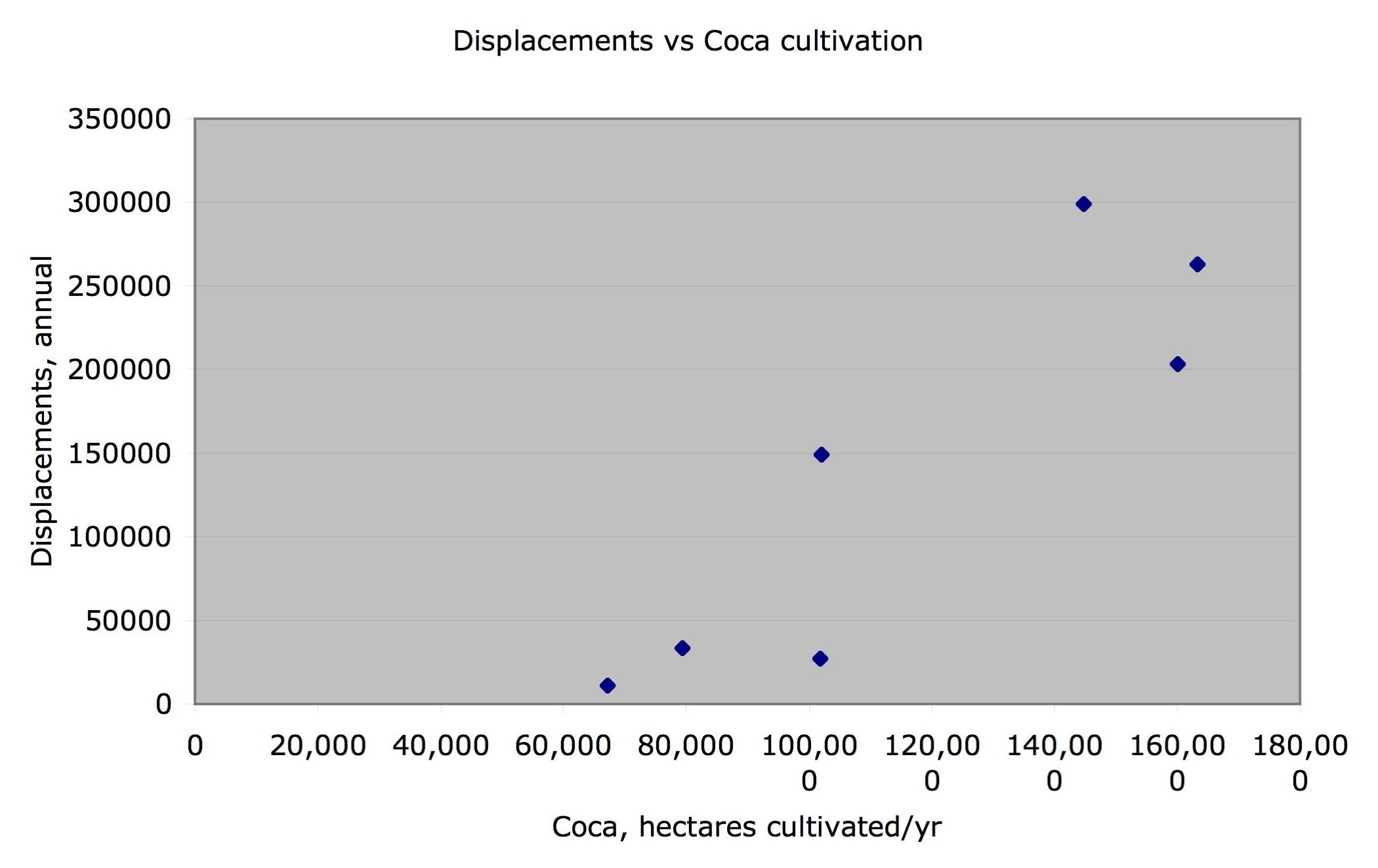 As a rough guide, statistical correlation can be seen graphically on a scatter plot when data points appear to be clustered around a certain line: the closer the data points are clustered along a line, the greater the correlation; the less clustered, the less correlation. A statistical measure of correlation known as the correlation coefficient, or r, measures this clustering. Correlations are weakest when |r| = 0 and strongest when |r| = 1. As an independent variable, coca cultivation appears to have a significant correlation with the phenomenon of displacements (see graph): |r| = 0.825. If there is a causal connection here, it may be due to the fact that farmers who grow coca (cocaleros)become targets of crop fumigation, which destroys all their crops, not just the small portion of their farm which is dedicated to coca (Escobar). Also, cocaleros (or their children) may become targets for recruitment or persecution by the guerrillas (who want recruits) and the paramilitaries (who distrust cocaleros because they may be funding the guerrillas). Alternatively, the land of farmers who flee the countryside may be taken over by others who use it for coca production, which would account for the correlation. Data on coca cultivation come from the United Nations Office on Drugs and Crime.
As a rough guide, statistical correlation can be seen graphically on a scatter plot when data points appear to be clustered around a certain line: the closer the data points are clustered along a line, the greater the correlation; the less clustered, the less correlation. A statistical measure of correlation known as the correlation coefficient, or r, measures this clustering. Correlations are weakest when |r| = 0 and strongest when |r| = 1. As an independent variable, coca cultivation appears to have a significant correlation with the phenomenon of displacements (see graph): |r| = 0.825. If there is a causal connection here, it may be due to the fact that farmers who grow coca (cocaleros)become targets of crop fumigation, which destroys all their crops, not just the small portion of their farm which is dedicated to coca (Escobar). Also, cocaleros (or their children) may become targets for recruitment or persecution by the guerrillas (who want recruits) and the paramilitaries (who distrust cocaleros because they may be funding the guerrillas). Alternatively, the land of farmers who flee the countryside may be taken over by others who use it for coca production, which would account for the correlation. Data on coca cultivation come from the United Nations Office on Drugs and Crime.
 As an independent variable, GDP change appears to have no correlation with any of the three misery indicators. For example, see the graph showing GDP change versus kidnappings. This may be because GDP growth has no immediate or direct effect either on the well-being of the poor or on the intensity of the civil war. Figures on GDP change come from the World Bank and the Colombian statistics office, Dirección Nacional Administrativa de Estadísticas.
As an independent variable, GDP change appears to have no correlation with any of the three misery indicators. For example, see the graph showing GDP change versus kidnappings. This may be because GDP growth has no immediate or direct effect either on the well-being of the poor or on the intensity of the civil war. Figures on GDP change come from the World Bank and the Colombian statistics office, Dirección Nacional Administrativa de Estadísticas.
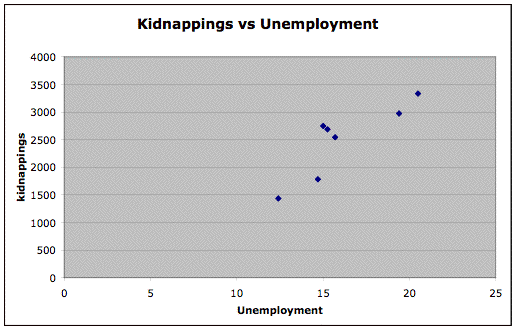 There is a weak correlation between unemployment and homicides. Homicide is high no matter where unemployment is, but to the degree that people are forced economically into drugs or other risky occupations, that would account for this correlation. Unemployment data is provided by the International Labour Organization. There is, however, an impressive correlation between unemployment and kidnapping (see graph). The correlation coefficient for this dataset is r = 0.86.
There is a weak correlation between unemployment and homicides. Homicide is high no matter where unemployment is, but to the degree that people are forced economically into drugs or other risky occupations, that would account for this correlation. Unemployment data is provided by the International Labour Organization. There is, however, an impressive correlation between unemployment and kidnapping (see graph). The correlation coefficient for this dataset is r = 0.86.
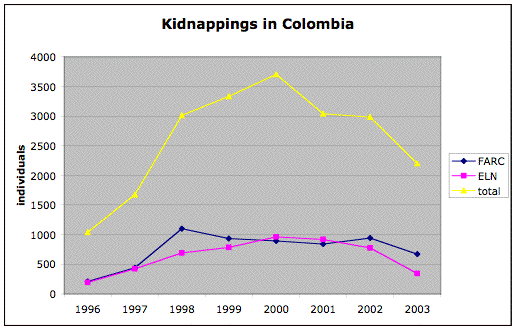 Now, consider that while the two main guerrilla groups, the FARC and the ELN, are responsible for many kidnappings per year (see graph), many of these incidents are not initiated by them. In fact, they subcontract to others, paying their accomplices when the victim is delivered, or paying a portion of the ransom when the victim is released (CountryWatch). Therefore, to the degree that economic hardship leads ordinary criminals to take up kidnapping work on behalf of the guerrillas (or on their own account), this may account for the correlation.
Now, consider that while the two main guerrilla groups, the FARC and the ELN, are responsible for many kidnappings per year (see graph), many of these incidents are not initiated by them. In fact, they subcontract to others, paying their accomplices when the victim is delivered, or paying a portion of the ransom when the victim is released (CountryWatch). Therefore, to the degree that economic hardship leads ordinary criminals to take up kidnapping work on behalf of the guerrillas (or on their own account), this may account for the correlation.
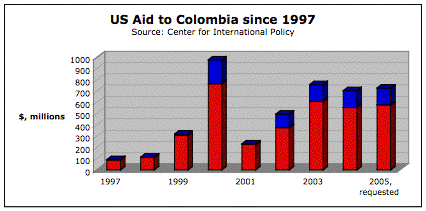 It is clear that economic hardship plays some role in aggravating the crisis in Colombia. What about the United States? See the graph detailing U.S. aid since 1997. The lower part of each bar represents military and police-related funding, training, and equipment transfers. Part of the funding in this category goes to pay the DynCorp contractors who spray coca crops with a variety of the Monsanto fumigant Roundup which is not sold in the United States. The upper part of each bar, which comes to nearly nothing in 1997-99 and in 2001, represents economic and social assistance programs. These are general economic development projects and State Department-managed funding for economic and social programs expressly designed to be counter-narcotics, including the development of alternative crops to encourage farmers to abandon coca production voluntarily. The data was compiled by the Center for International Policy.
It is clear that economic hardship plays some role in aggravating the crisis in Colombia. What about the United States? See the graph detailing U.S. aid since 1997. The lower part of each bar represents military and police-related funding, training, and equipment transfers. Part of the funding in this category goes to pay the DynCorp contractors who spray coca crops with a variety of the Monsanto fumigant Roundup which is not sold in the United States. The upper part of each bar, which comes to nearly nothing in 1997-99 and in 2001, represents economic and social assistance programs. These are general economic development projects and State Department-managed funding for economic and social programs expressly designed to be counter-narcotics, including the development of alternative crops to encourage farmers to abandon coca production voluntarily. The data was compiled by the Center for International Policy.
This shows the overall thrust of American policy: even during the Clinton years, and under the Pastrana administration (which Colombians elected because of his pro-peace negotiations platform), the program's balance was in favor of military and police work, not economic or social development.
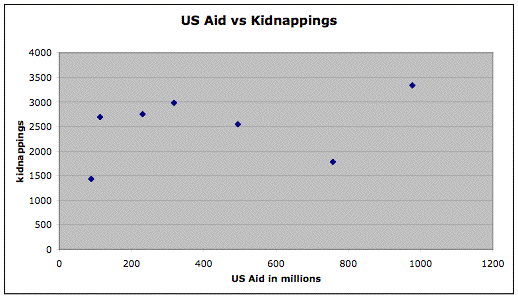
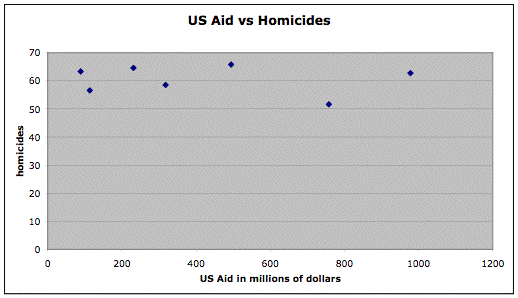
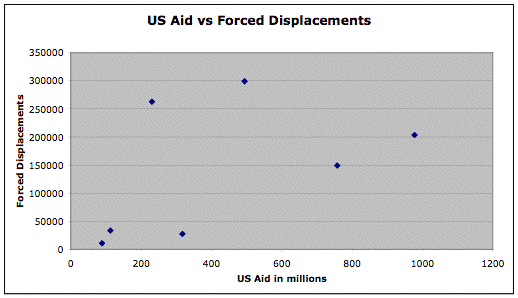
Here we see scatter plots that show weak correlation between U.S. aid and the misery indicators. |r| for U.S. Aid vs kidnapping is r = 0.314. It is weaker for homicides: |r| = 0.164. For forced displacements, it is stronger than the previous two but still weak: |r| = 0.438.
The greater correlation for forced displacements may be due to the fact that of my three misery indicators, forced displacements is the one that is most closely linked to the civil war. These are people who flee their villages because they fear death. As the war intensifies, with the U.S. strengthening the army's ability to project power into the countryside, more people will be forced out of their homes.
The conclusion is that, given my use of the three misery indicators as suggestive of the overall level of crisis in the country, the present statistical data I have gathered cannot support the statement that U.S. involvement in Colombia is worsening or improving the social situation there. It should be noted that my indicators have little to do with human rights abuses (although forced displacement does imply a loss of economic rights). This is because I did not trust the available data: the State cannot be expected to provide reliable information about the tortures it carries out upon dissidents, or about its collaboration with the paramilitaries. With my present resources, I had to settle for the less-controversial indicators. It remains for another paper to look at the effect of U.S. involvement on human rights abuses. Presently, however, we must turn to more political analysis to make sense of the data, and to think about the question. The one thing that is clear is that American involvement is overwhelmingly military.
The Colombian body politic accepted the need for a negotiated peace in 1998, when they elected Andrés Pastrana. But after establishing a huge demilitarized zone to satisfy a rebel precondition for negotiations, the nation saw little progress. The FARC argues that Pastrana negotiated in bad faith, pointing to the Plan Colombia (under which the U.S. nearly tripled annual aid in 2000) as evidence that the state was gearing up for an assault. The discovery of drug labs, where coca leaves were refined into the base paste for cocaine, and several small landing strips in the jungle, which the government accused the rebels of using to ship drugs out of the country, deprived the FARC of credibility, as they were seen as having lost their ideology and getting rich off the war by selling drugs and kidnapping ordinary Colombians. The nation, now led by right-wing hardliner Álvaro Uribe, he of the "heavy hand" (mano dura), seems resolved to fight it out.
And not without reason. When I went to Medellín, Colombia, last summer, signs posted above the freeway read "Ya regresó la vuelta al oriente" ("touring the east is back"). Before Uribe's election, it was impossible to travel far beyond the city limits to the east, because it was rebel territory. Kidnappings and murder were rife; the governor of the state of Antioquia (of which Medellín is the capital) and his commissioner for peace were kidnapped by the FARC during a peace march through the countryside and later murdered. With the advent of Uribe, who is from Antioquia, having served as its governor (1995-97) and as mayor of Medellín (1982-1984), security has been greatly increased. Whether this is because of the "democratic security" strategy, or because he has directed security resources towards his home town, is uncertain. What is common knowledge is that he is close friends with the Ochoa brothers, horse fanciers and two of the most powerful drug barons in the country, and that he is one of the co-founders of CONVIVIR, one of the earliest paramilitary groups.
There are two problems with the military route. They are the Andes mountains and the Amazon rainforest. Some of the guerrillas, including the FARC's leader Manuel "Tirofijo" (Sureshot) Marulanda, have been in the bush for forty years. In the jungles and mountains, they are near-invulnerable. Denying them their "natural base of support" by terrorizing peasants, which the AUC is doing, or robbing their financial base by fumigating coca, are both probably vain efforts, and they have massive collateral damage to the population. Also, the majority of coca is grown in the southern part of the country, whose rivers drain directly into the Amazon; when Roundup is sprayed, this chemical, which has been linked to major outbreaks of respiratory and other illnesses among the populations over which it is indiscriminately dispersed, flushes into the greatest zone of biodiversity on the planet (Escobar).
In this context, the best thing the United States could do is use its influence with the state to pursue peace talks. The intransigent ruling class of Colombia, the owners of the factories whose union organizers are killed, the owners of the newspapers whose reporters are killed, must accept that the FARC came into existence and continues to exist because of the plight of the peasant and the poverty of the urban worker. The FARC also must receive guarantees that what happened in the 80s will not happen again. In 1984 a cease-fire was reached, and they founded a peaceful political movement, the UP [Patriotic Union], together with the Colombian Communist Party. Over the next several years, 3000 of its activists and leaders were murdered. This had the effect of liquidating the FARC's moderate wing and most of its intellectual leadership: a "political genocide" according to filmmaker Patricia Castaño in her movie War Takes.
Caution must be exercised with regard to US assistance in peace talks. Soon after taking office, Uribe asked the Catholic Church to use its good offices to arrange communications with the FARC. This was perceived as a slap in the face by the Marxist guerrillas, above all because communication between the government and their general staffs had been direct during the Pastrana administration. The role of outsiders, particularly the U.S., in developing the peace process should be measured according to the needs of both parties, both of whom must come to the negotiating table in good faith. The FARC is never going to take the capital, Bogotá; the U.S. is present in Colombia like it was not in Cuba, and the country is much bigger than Nicaragua was. The state is never going to destroy the FARC in the countryside. The recognition of these facts should be the basis for a new round of talks that should lead to peace.
Table 1. Global statistics list
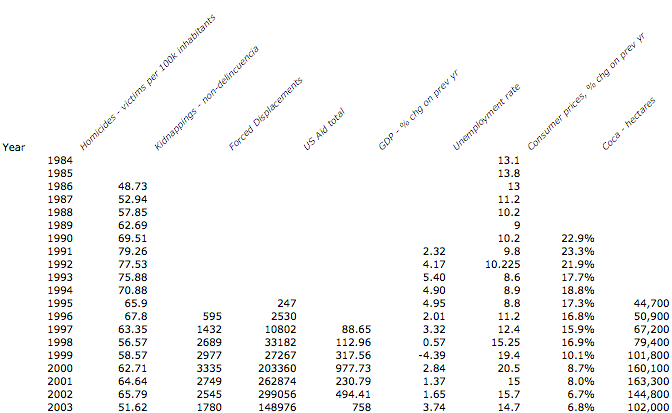
1 Both the guerrillas and paramilitaries practice "low-intensity warfare", living off the land, moving clandestinely, and fighting using hit-and-run tactics. Thus they are similar in many respects, though the guerrillas still espouse Marxist ideology, and the paramilitary groups together with the army are accused by many NGOs of up to 80% of all human-rights violations in Colombia.
Asociación Nacional de Empresarios de Colombia. "Conflicto Armado Colombiano #525." 5/17/02. Accessed on 14 May 2004 at http://www.andi.com.co/ dependencias/sriagral/Conflicto2002/Conflicto525.htm.
Cardona, Luís Adolfo. Lecture on unionism, paramilitaries, and exile. Sponsored by the Latin American Student Association, University of California, Berkeley, March 9, 2004.
Center for International Policy. "U.S. Aid to Colombia since 1997: Summary Tables". Accessed 29 April 2004 at http://ciponline.org/colombia/aidtable.htm.
Centro de Investigación y Educación Popular. "Cifras de la violencia política, Enero - Junio de 2003." Noche y niebla vol. 27. Accessed 23 Feb 2004 at http://www.nocheyniebla.org/27/pdf/cifras.pdf.
CIA, United States of America. "Colombia." The World Factbook. Accessed online 28 Feb 2004, at http://www.cia.gov/cia/publications/factbook/geos/co.html.
Collier, Ruth B. and David Collier. Shaping the Political Arena. Notre Dame, Indiana: U of Notre Dame P, 2002.
CountryWatch. "Colombian rebel extortion chief arrested." Accessed online on 15 Apr 2004 at http://www.countrywatch.com/cw_wire.asp? vCOUNTRY=38&UID=693820.
Dirección Nacional Administrativo de Estadística - Republic of Colombia. "Colombia, Producto Interno Bruto PIB a precios constantes de 1994". Accessed 5 Mar 2004 at http://www.dane.gov.co/inf_est/pib/ctas_nales/1994-2000/ctas_nles_PIB%20a%20precios%20constantes%20de%201994%201990-01.xls.
"Country Briefings: Colombia." The Economist. Accessed 14 May 2004 at http://www.economist.com.
Escobar, Michael N. "Plátanos negros y niños enfermos." El Lancero. Pasadena City College, Pasadena, California, February 2002.
Freedman, David, Robert Pisani, and Roger Purves. Statistics. New York: Norton, 1991.
FONDELIBERTAD - Ministerio de Defensa Nacional, Republic of Colombia. "Tablas Situación General de Secuestro en Colombia 1996 - 2004". Accessed 30 Apr 2004 at http://www.antisecuestro.gov.co/Documentos/Datos%201996%20-%202004.xls.
Hillman, Richard S., ed. Understanding Contemporary Latin America. Boulder, Colorado: Lynne Riener Publishers, 1997.
International Labour Organization. LABORSTA Labour Statistics Database. Accessed 15 Apr 2004 at http://laborsta.ilo.org.
MacEoin, Gary. Colombia and Venezuela and the Guianas. New York: Time Incorporated, 1965.
Madero, Régulo. Guest lecture on human rights, the situation in Barrancabermeja, and unionism. Pasadena City College, Pasadena, California, 1999.
McInerny, Andy. Lecture on the Colombia situation given at the International Action Center, Los Angeles, 2001.
Miller, T. Christian. "Riding Shotgun on a Pipeline." Los Angeles Times. May 16, 2004. Accessed online on 17 May 2004, at http://www.latimes.com/news/nationworld/ world/la-fg-arauca16may16,1,2862007.story?coll=la-home-headlines.
Red de Solidaridad Social - Presidencia de la República, Republic of Colombia. "Registro único de Población Desplazada por la Violencia". Accessed 4 May 2004 at http://www.red.gov.co/Download/Files/Registro_SUR/Registro_SUR_Mzo_31_2004/Registro_SUR_Mzo_31_web_a%f1os.htm.
Reporters Without Borders. "2003 Round-up". Accessed 2 Mar 2003 at http://www.rsf.org/article.php3?id_article=8969.
United Nations Economic and Social Council Commission on Human Rights. Report of the United Nations High Commissioner for Human Rights on the human rights situation in Colombia. Accessed online 25 April 2004 at http://www.un.org.
United Nations Economic Commission on Latin America and the Caribbean.
I. "Globalización y desarrollo". April 2002. Accessed online 10 April 2004 at http://www.cepal.org/cgi-bin/getProd.asp?xml=/publicaciones/xml/6/10026/P10026.xml&xsl=/tpl/p9f.xsl&base=/tpl/top-bottom.xsl.
II. "Anuario estadístico de América Latina y el Caribe 2002". April 2003. Accessed online 1 Apr 2004 at http://www.cepal.org/cgi-bin/getProd.asp?xml=/publicaciones/xml/5/12165/P12165.xml&xsl=/deype/tpl/p9f.xsl&base=/tpl/top-bottom.xsl.
United Nations Office on Drugs and Crime. "Colombia Coca Survey for December 2002 and Semi-Estimate for July 2003". Accessed 29 Apr 2004 at http://www.unodc.org/pdf/publications/colombia_report_2003-09-25.pdf.
Vicepresidencia de la República - Programa Presidencial por los Derechos Humanos y DIH, Republic of Colombia. "Informe anual de derechos humanos y DIH 2003". Accessed 23 Mar 2004 at http://www.derechoshumanos.gov.co/descargas/ informe2003/informeanual2003.pdf.
World Bank. World Development Indicators Database. Accessed 16 May 2004 at http://devdata.worldbank.org/data-query/.
Home